A Thermally Controlled Multifunctional Metamaterial Absorber with Switchable Wideband Absorption and Transmission at THz Band
Abstract
1. Introduction
2. Model Design
3. Results and Discuss
4. Conclusions
Author Contributions
Funding
Institutional Review Board Statement
Informed Consent Statement
Data Availability Statement
Conflicts of Interest
References
- Pendry, J.B. Negative refraction makes a perfect lens. Phys. Rev. Lett. 2000, 85, 3966–3969. [Google Scholar] [CrossRef]
- Zhang, H.; Jiao, Z.Y.; Mcleod, E. Tunable terahertz hyperbolic metamaterial slabs and super−resolving hyperlenses. Appl. Opt. 2020, 59, G64–G70. [Google Scholar] [CrossRef] [PubMed]
- Mukherjee, S.; Su, Z.Y.; Udpa, L.; Udpa, S.; Tamburrino, A. Enhancement of microwave imaging using a metamaterial lens. IEEE Sens. J. 2019, 19, 4962–4971. [Google Scholar] [CrossRef]
- Quader, S.; Akram, M.R.; Xiao, F.J.; Zhu, W.R. Graphene based ultra−broadband terahertz metamaterial absorber with dual −band tenability. J. Opt. 2020, 22, 095104. [Google Scholar] [CrossRef]
- Zhang, J.; Wei, X.Z.; Premaratne, M.; Zhu, W.R. Experimental demonstration of electrically tunable broadband coherent perfect absorber based on graphene−electrolyte−graphene sandwich structure. Photonics Res. 2019, 7, 868–874. [Google Scholar] [CrossRef]
- Xie, J.W.; Quader, S.; Xiao, F.J.; He, C.; Liang, X.L.; Geng, J.P.; Jin, R.H.; Zhu, W.R.; Rukhlenko, I.D. Truly all−dielectric ultra−broadband metamaterial absorber: Water−based and ground−free. IEEE Antennas Wirel. Propag. Lett. 2019, 18, 536–540. [Google Scholar] [CrossRef]
- Wu, Z.H.; Zhao, J.M.; Chen, K.; Feng, Y.J. An active metamaterial absorber with ultrawideband continuous tenability. IEEE Access 2022, 10, 25290. [Google Scholar] [CrossRef]
- Islam, S.S.; Faruque MR, I.; Islam, M.T. A dual−polarized metamaterial−based cloak. Mater. Res. Bull. 2017, 96, 250–253. [Google Scholar] [CrossRef]
- Choudhury, B.; Jha, R.M. A review of metamaterial invisibility cloaks. CMC−Comput. Mater. Contin. 2013, 33, 275–308. [Google Scholar]
- Karaaslan Muharrem Karaaslan, M.; Karaaslan Muharrrem Karaaslan, M. Microwave metamaterial absorber for sensing applications. OPTO−Electron. Rev. 2017, 25, 318–325. [Google Scholar]
- Tak, J.; Lee, Y.; Choi, J. Design of a metamaterial absorber for ISM applications. J. Electromagn. Eng. Sci. 2013, 13, 1–7. [Google Scholar] [CrossRef]
- Landy, N.I.; Bingham, C.M.; Tyler, T.; Jokerst, N.; Smith, D.R.; Padilla, W.J. Design, theory, and measurement of a polarization −insensitive absorber for terahertz imaging. Phys. Rev. B 2009, 79, 125104. [Google Scholar] [CrossRef]
- Escorcia, I.; Grant, J.; Gough, J.; Cumming DR, S. Uncooled CMOS terahertz imager using a metamaterial absorber and pn diode. Opt. Lett. 2016, 41, 3261–3264. [Google Scholar] [CrossRef]
- Mulla, B.; Sabah, C. Ultrathin thermally stable multiband metamaterial absorber design for solar energy applications. J. Nanophotonics 2018, 12, 016005. [Google Scholar] [CrossRef]
- Feng, L.; Huo, P.C.; Liang, Y.Z.; Xu, T. Photonic Metamaterial Absorbers: Morphology Engineering and Interdisciplinary Applications. Adv. Mater. 2020, 32, 1903787. [Google Scholar] [CrossRef]
- Zhang, Y.; Feng, Y.J.; Zhu, B.; Zhao, J.M.; Jiang, T. Graphene based tunable metamaterial absorber and polarization modulation in terahertz frequency. Opt. Express 2014, 22, 22743–22752. [Google Scholar] [CrossRef]
- Zhang, F.L.; Li, C.; Fan, Y.C.; Yang, R.S.; Shen, N.H.; Fu, Q.H.; Zhang, W.H.; Zhao, Q.; Zhou, J.; Koschny, T.; et al. Phase-modulated scattering manipulation for exterior cloaking in metal–dielectric hybrid metamaterials. Adv. Mater 2019, 31, 1903206. [Google Scholar] [CrossRef]
- Yang, Y.F.; Zhao, W.B.; Wu, Z.H.; Zhao, J.M.; Jiang, T.; Chen, K.; Feng, Y.J. Three−dimensional lightweight metamaterial with ultra−wideband microwave absorption. Microw. Opt. Technol. Lett. 2022, 64, 500. [Google Scholar] [CrossRef]
- Wang, X.; Wang, J.L. Terahertz metamaterial absorber sensor based on three−dimensional split−ring resonator array and microfluidic channel. Acta Opt. Sin. 2020, 40, 1904001. [Google Scholar] [CrossRef]
- Han, Y.; Che, W.Q.; Xiu, X.; Yang, W.C.; Christopoulos, C. Switchable low−profile broadband frequency−selective rasorber/absorber based on slot arrays. IEEE Trans. Antennas Propag. 2017, 65, 6998–7008. [Google Scholar] [CrossRef]
- Ghosh, S. Polarization−insensitive switchable frequency−selective rasorber/Absorber. In Proceedings of the IEEE Asia−Pacific Microwave Conference (APMC), Singapore, 10–13 December 2019; pp. 399–401. [Google Scholar]
- Qu, M.J.; Chang, T.Y.; Guo, G.; Li, S.F. Design of graphene−based dual−polarized switchable rasorber/absorber at Terahertz. IEEE Access 2020, 8, 127220–127225. [Google Scholar] [CrossRef]
- Bakshi, S.C.; Mitra, D.; Teixeira, F.L. Wide−angle broadband rasorber for switchable and conformal application. IEEE Trans. Microw. Theory Tech. 2021, 69, 1205–1216. [Google Scholar] [CrossRef]
- Jepsen, P.U.; Fischer, B.M.; Thoman, A.; Helm, H.; Suh, J.Y.; Lopez, R.; Haglund, R.F. Metal−insulator phase transition in a VO2 thin film observed with terahertz spectroscopy. Phys. Rev. B 2006, 74, 205103. [Google Scholar] [CrossRef]
- Niu, J.H.; Yao, Q.Y.; Mo, W.; Li, C.H.; Zhu, A.J. Switchable bi−functional metamaterial based on vanadium dioxide for broadband absorption and broadband polarization in terahertz band. Opt. Commun. 2022, 527, 128953. [Google Scholar] [CrossRef]
- Solanki, U.; Mandal, P. Phase sensitive VO2−metal switchable plasmonic metasurface for thermal controlling of broad band near−infrared absorption. Opt. Quantum Electron. 2022, 54, 794. [Google Scholar] [CrossRef]
- Dong, Y.F.; Yu, D.W.; Li, G.S.; Lin, M.T.; Bian, L.A. Terahertz Metamaterial Modulator Based on Phase Change Material VO2. Symmetry−Basel 2021, 13, 2230. [Google Scholar] [CrossRef]
- Liang, J.R.; Wang, K.Q.; Xuan, C.; Chen, Q.; Tai, W.W.; Ge, P.H.; Zhang, H.R. Room temperature H2S gas sensing performance of VO2 (A) nanowires with high aspect ratio. Sens. Actuators A Phys. 2022, 347, 113986. [Google Scholar] [CrossRef]
- Liang, J.R.; Wu, W.H.; Lou, Q.; Wang, K.Q.; Xuan, C. Room temperature NO2 sensing performance enhancement of VO2 (B) composited rGO structure. J. Mater. Sci. Mater. Electron. 2022, 33, 15473–15482. [Google Scholar] [CrossRef]
- Liang, J.R.; Lou, Q.; Wu, W.H.; Wang, K.Q.; Xuan, C. NO2 gas sensing performance of a VO2(B) ultrathin vertical nanosheet array: Experimental and DFT investigation. ACS Appl. Mater. Interfaces 2021, 13, 31968–31977. [Google Scholar] [CrossRef]
- Wang, Y.; Chen, Z.; Cui, Q. Tunable terahertz broadband bandpass filter based on vanadium dioxide. Acta Opt. Sin. 2021, 41, 2023002. [Google Scholar]
- Zhang, X.Q.; Yan, F.P.; Du, X.M.; Wang, W.; Zhang, M. Water−based broadband metamaterial absorber insensitive to angle and temperature. Chin. J. Lasers 2021, 48, 1613002. [Google Scholar]
- Shen, X.P.; Cui, T.J.; Ye, J.X. Dual band metamaterial absorber in microwave regime. Acta Phys. Sin. 2012, 61, 058101. [Google Scholar] [CrossRef]
- Gu, C.; Qu, S.B.; Pei, Z.B.; Xu, Z.; Lin, B.Q.; Zhou, H.; Bai, P.; Gu, W.; Peng, W.D.; Ma, H. Design of a wide−band metamaterial absorber based on resistance films. Acta Phys. Sin. 2011, 60, 087802. [Google Scholar]
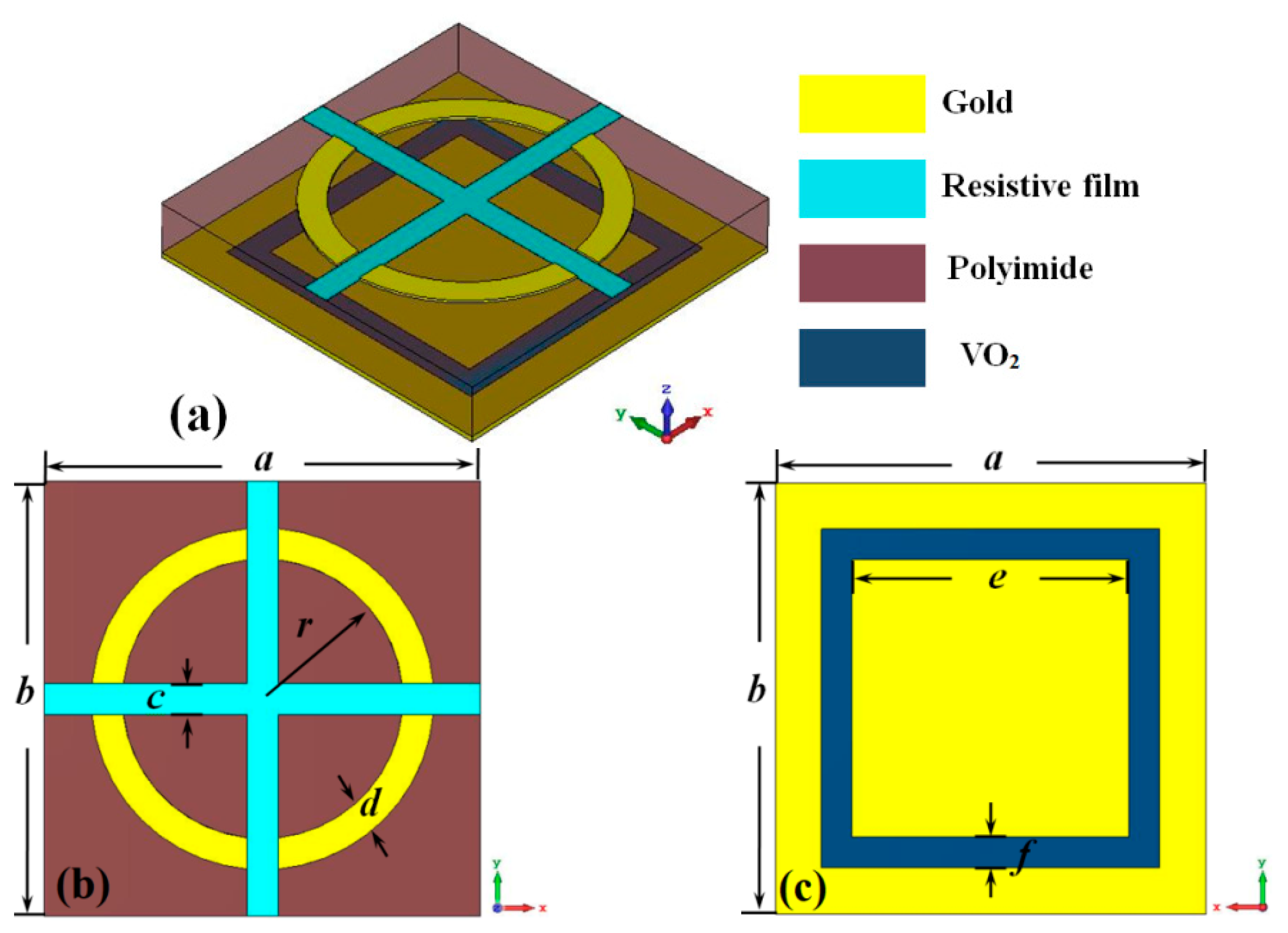
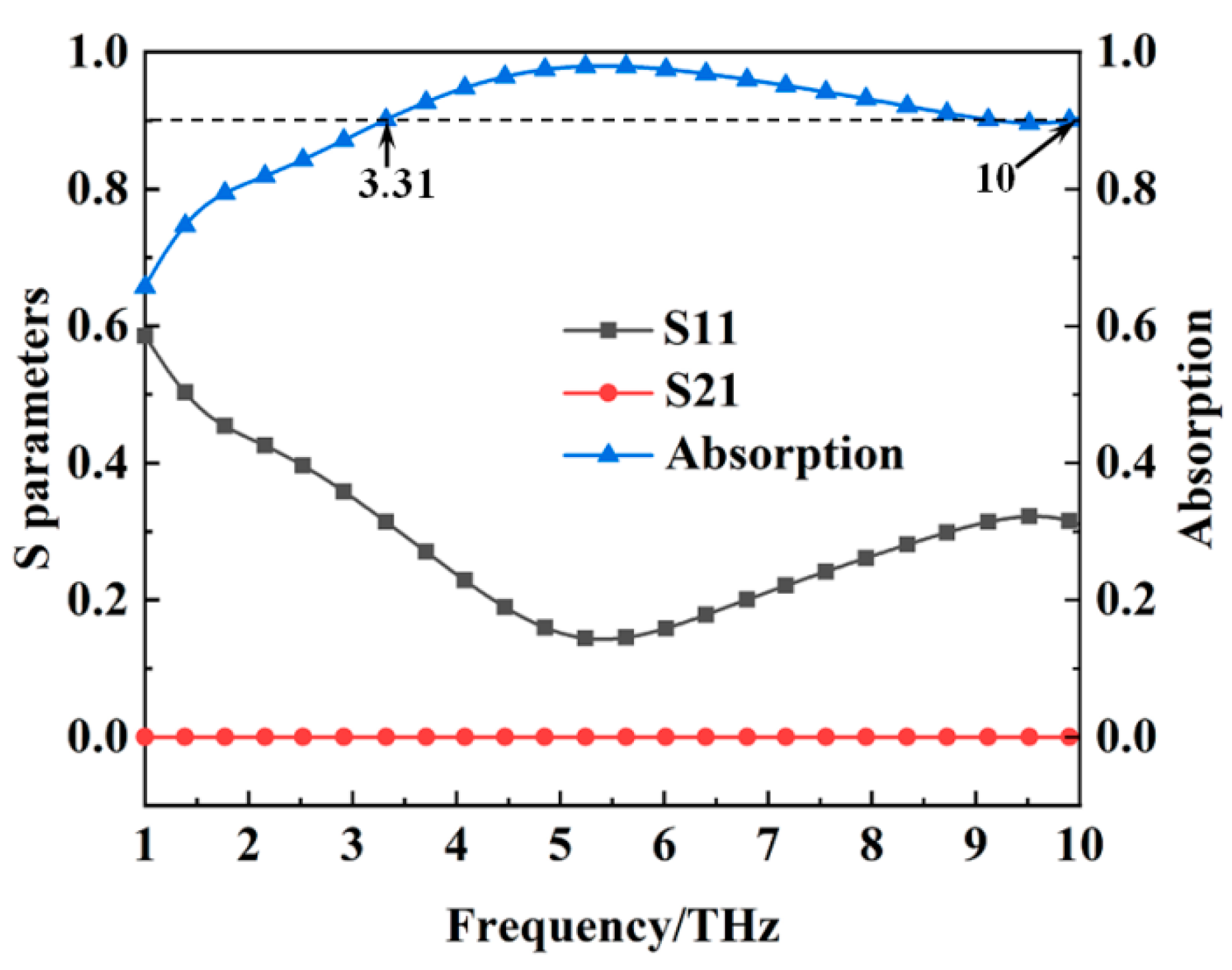
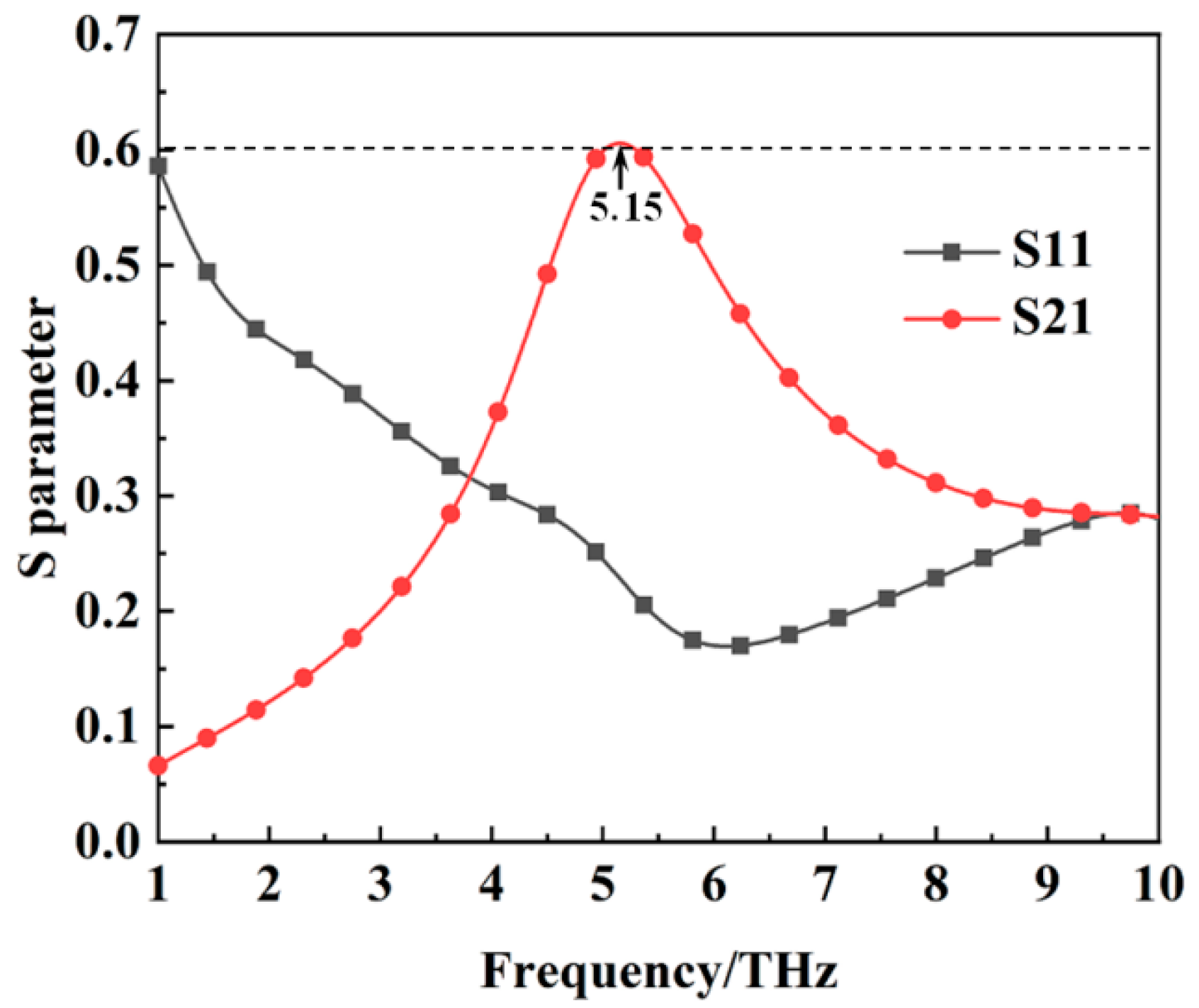
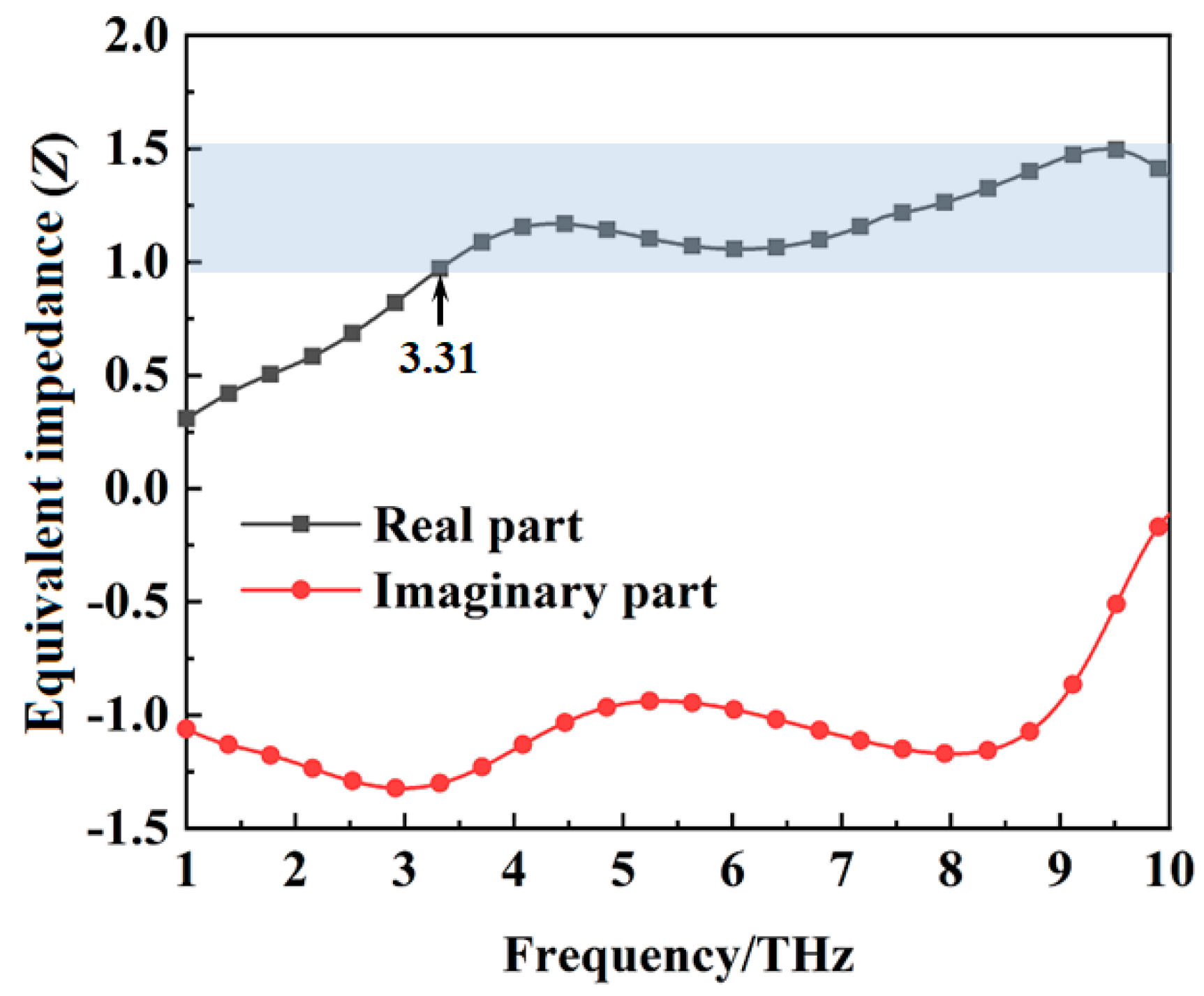
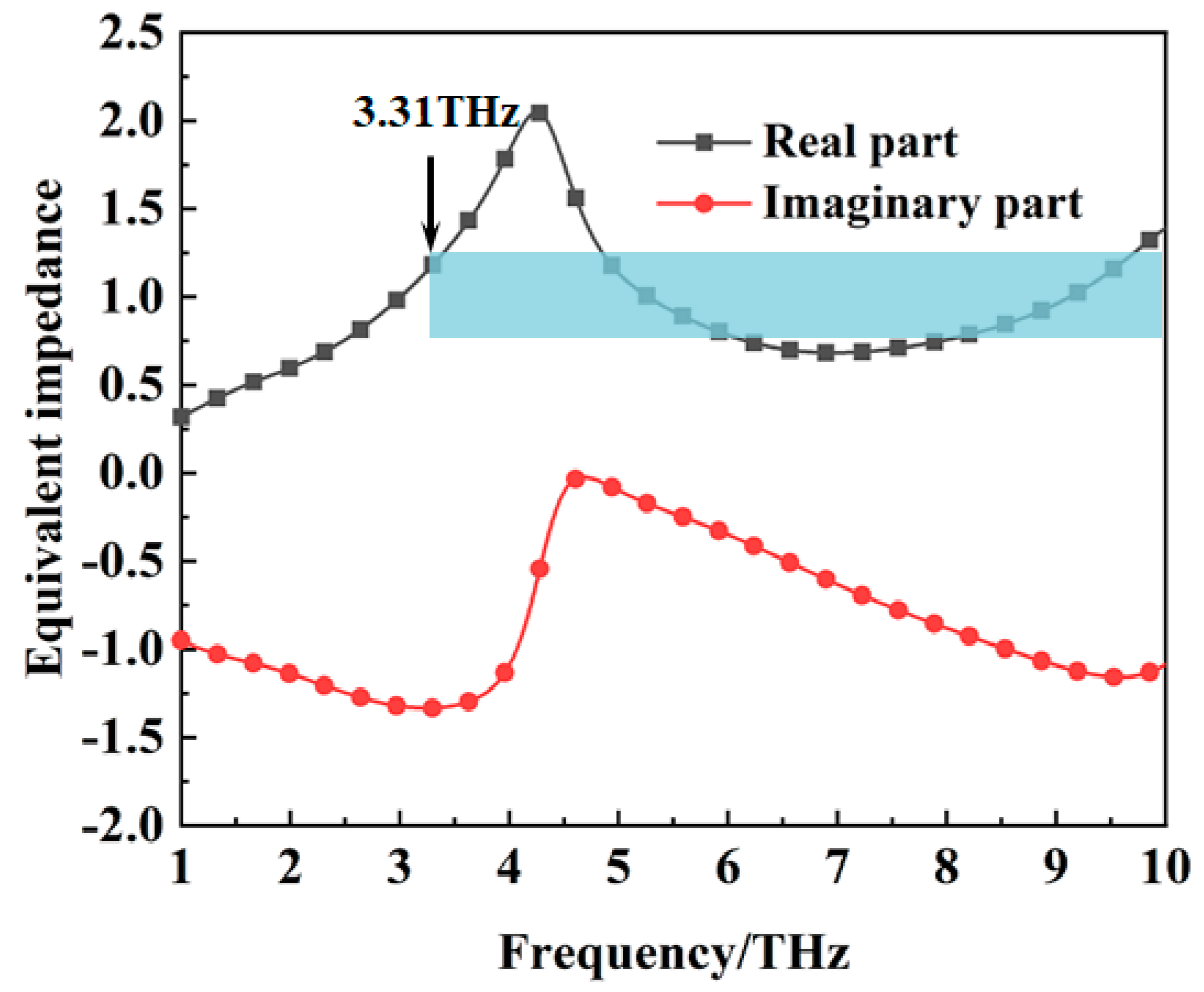
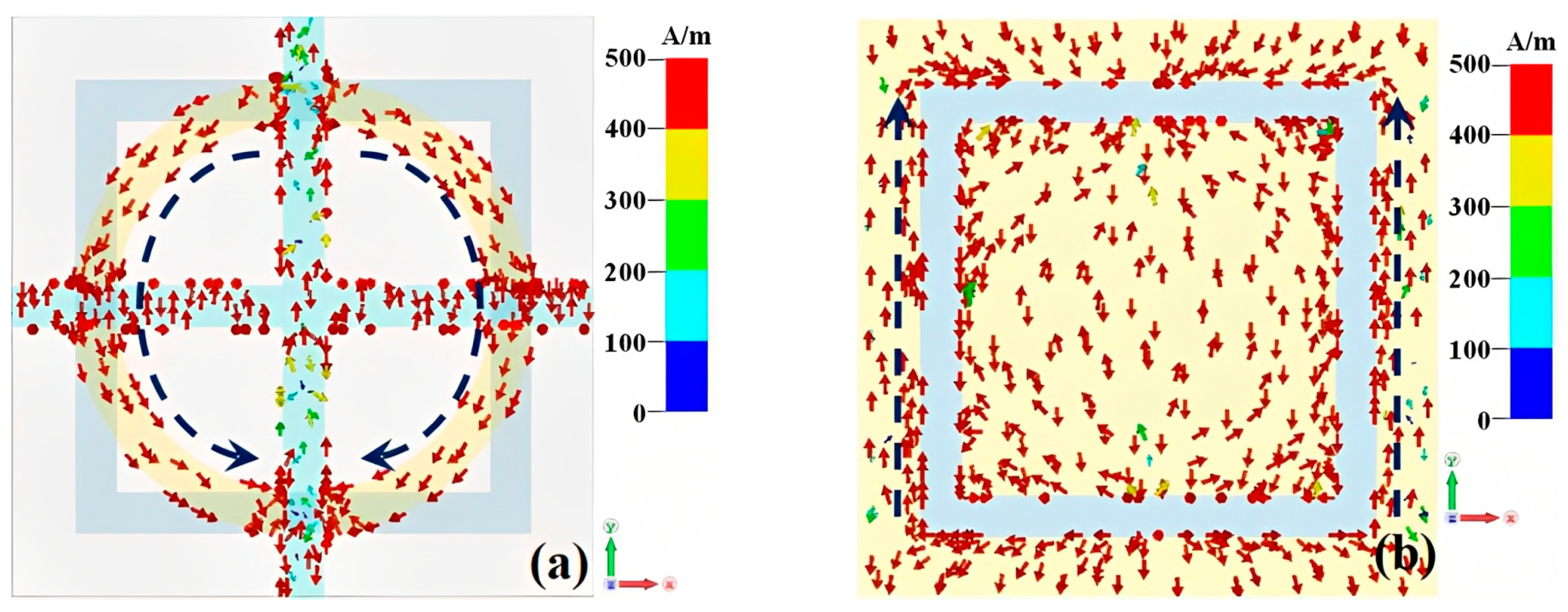
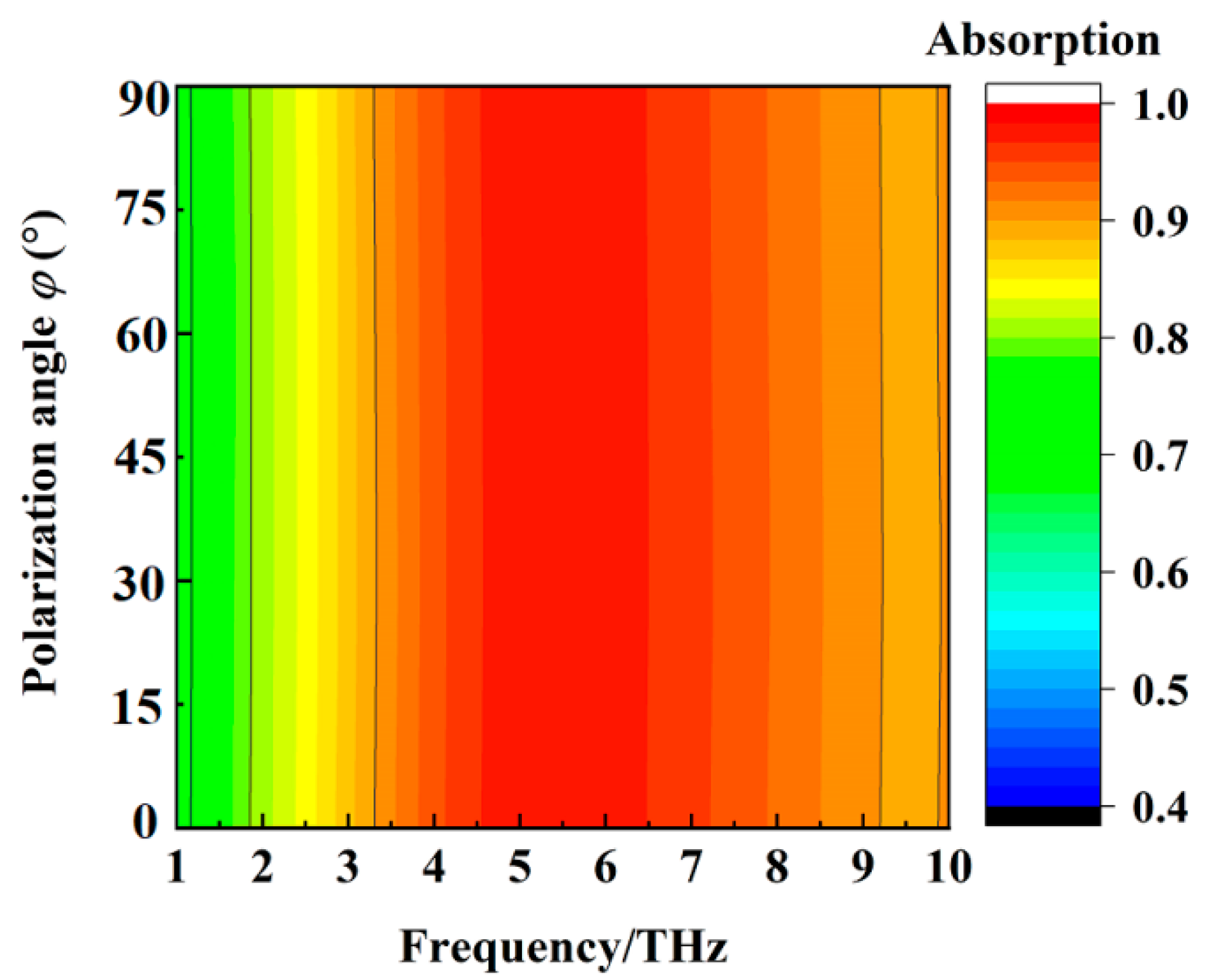
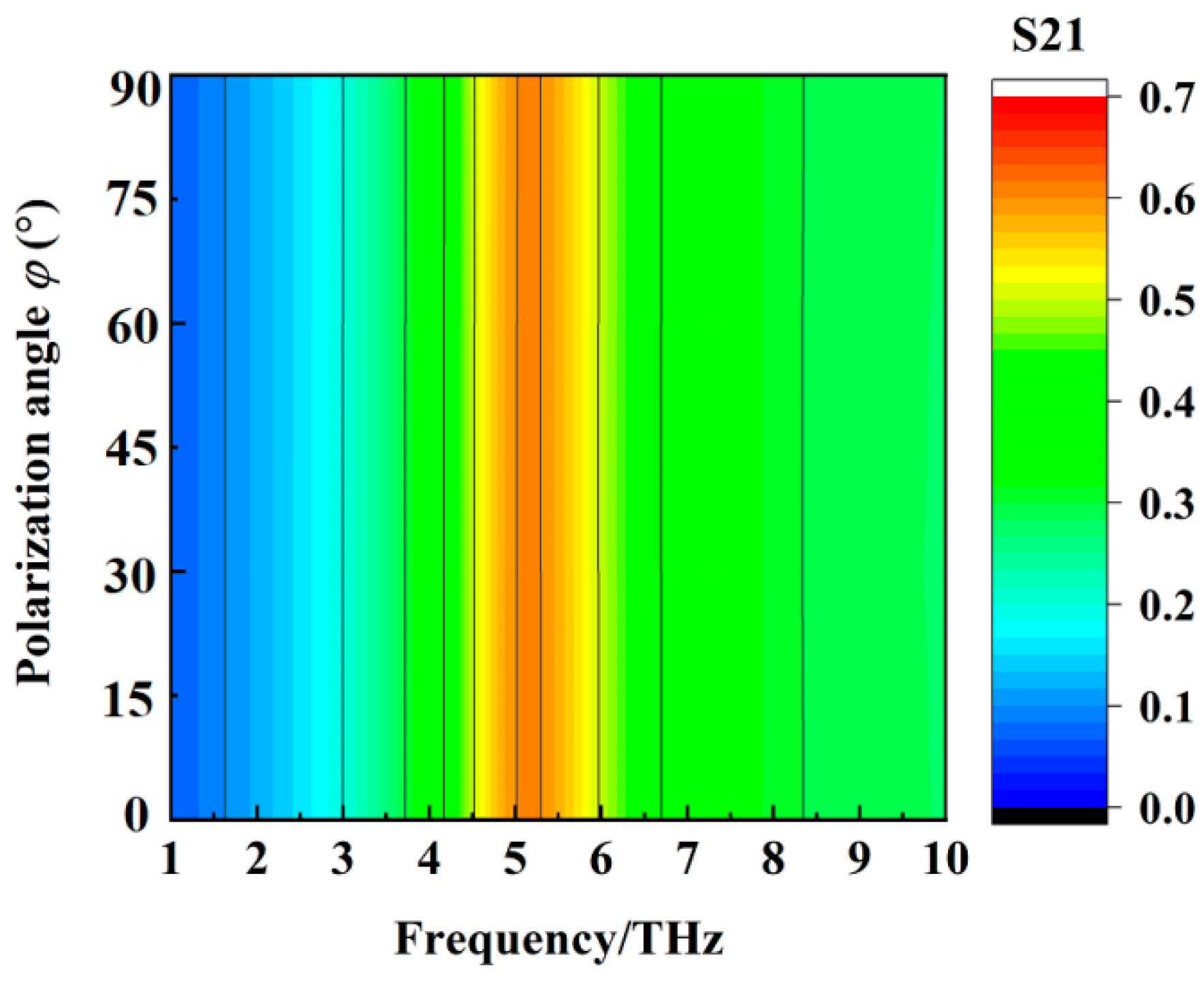
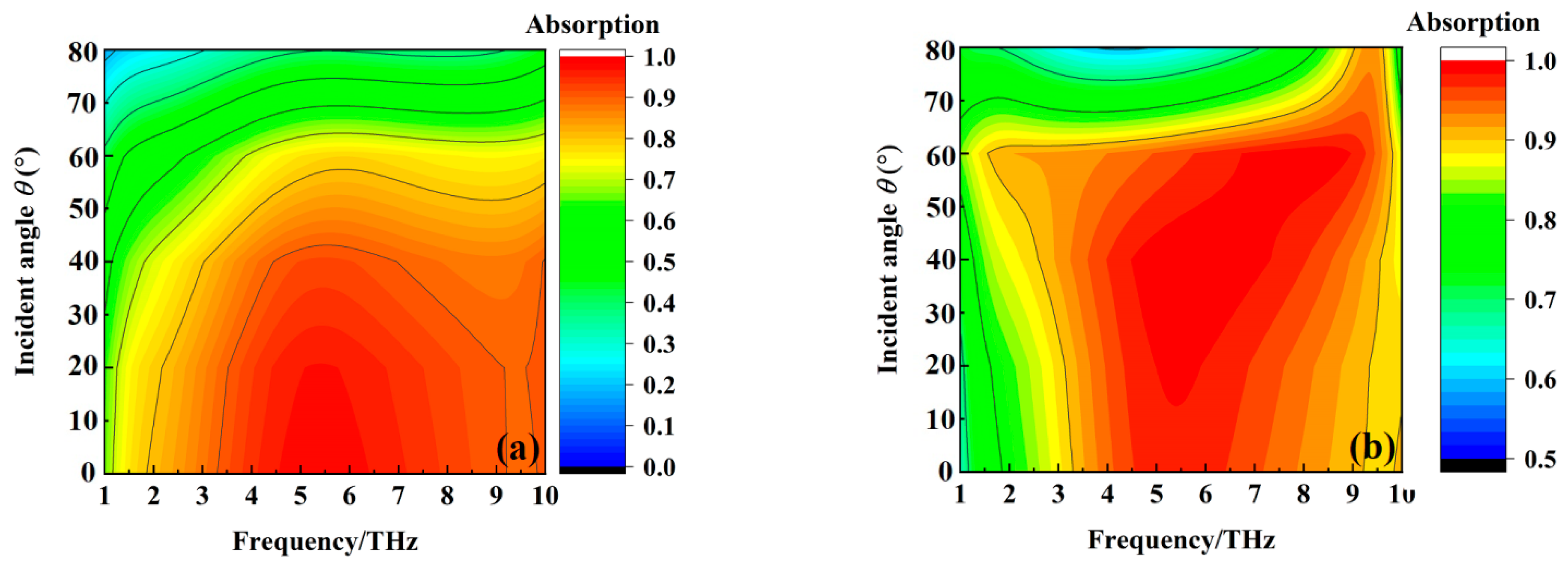

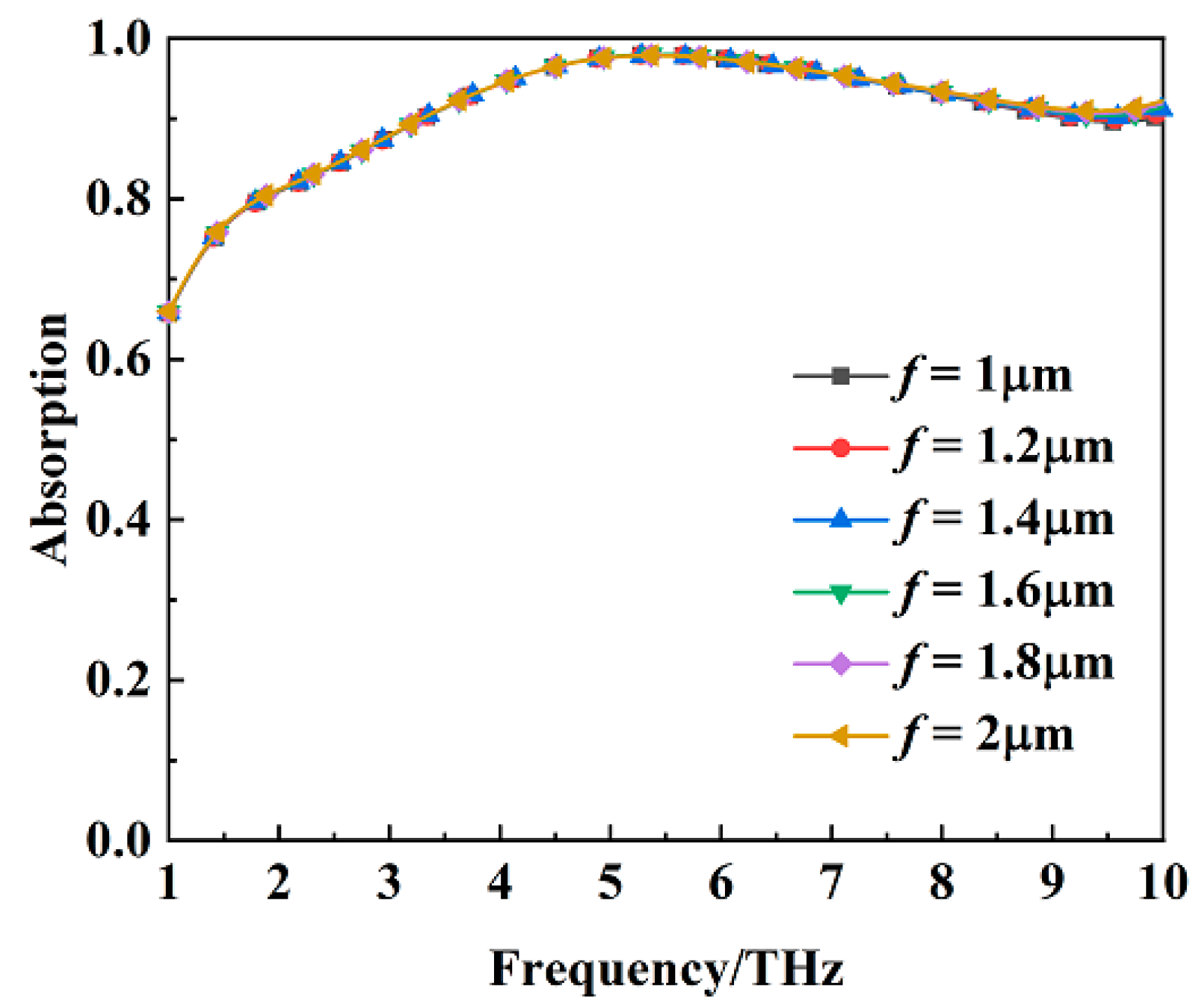
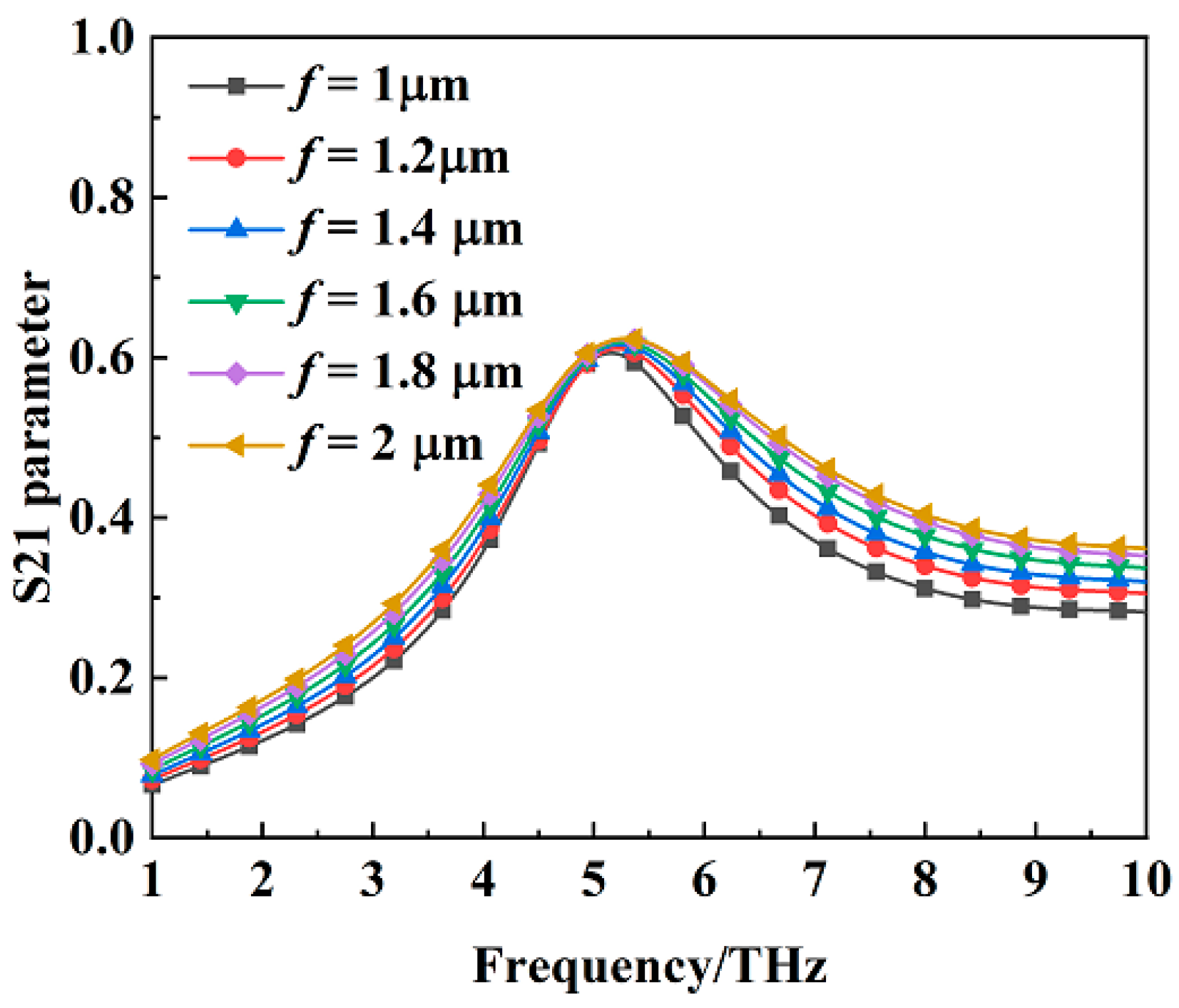
Disclaimer/Publisher’s Note: The statements, opinions and data contained in all publications are solely those of the individual author(s) and contributor(s) and not of MDPI and/or the editor(s). MDPI and/or the editor(s) disclaim responsibility for any injury to people or property resulting from any ideas, methods, instructions or products referred to in the content. |
© 2023 by the authors. Licensee MDPI, Basel, Switzerland. This article is an open access article distributed under the terms and conditions of the Creative Commons Attribution (CC BY) license (https://creativecommons.org/licenses/by/4.0/).
Share and Cite
Wang, L.; Fu, Q.; Wen, F.; Zhou, X.; Ding, X.; Wang, Y. A Thermally Controlled Multifunctional Metamaterial Absorber with Switchable Wideband Absorption and Transmission at THz Band. Materials 2023, 16, 846. https://doi.org/10.3390/ma16020846
Wang L, Fu Q, Wen F, Zhou X, Ding X, Wang Y. A Thermally Controlled Multifunctional Metamaterial Absorber with Switchable Wideband Absorption and Transmission at THz Band. Materials. 2023; 16(2):846. https://doi.org/10.3390/ma16020846
Chicago/Turabian StyleWang, Liansheng, Quanhong Fu, Fusan Wen, Xia Zhou, Xueyong Ding, and Yuan Wang. 2023. "A Thermally Controlled Multifunctional Metamaterial Absorber with Switchable Wideband Absorption and Transmission at THz Band" Materials 16, no. 2: 846. https://doi.org/10.3390/ma16020846
APA StyleWang, L., Fu, Q., Wen, F., Zhou, X., Ding, X., & Wang, Y. (2023). A Thermally Controlled Multifunctional Metamaterial Absorber with Switchable Wideband Absorption and Transmission at THz Band. Materials, 16(2), 846. https://doi.org/10.3390/ma16020846





